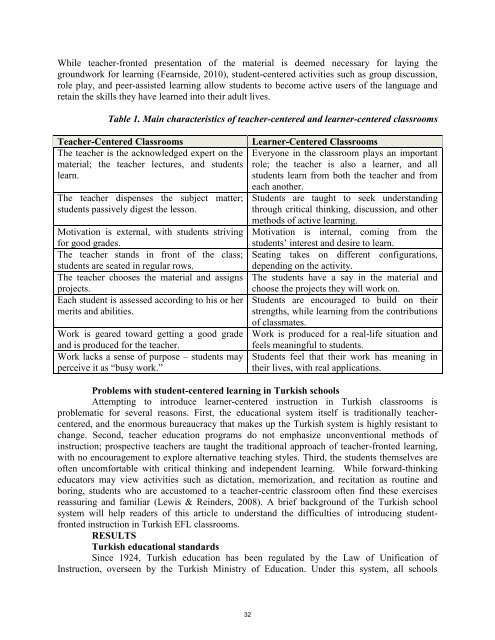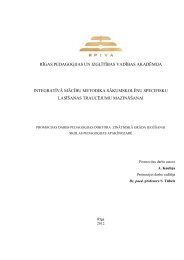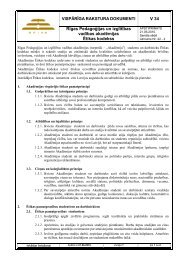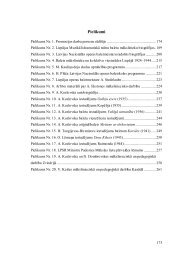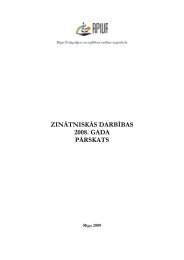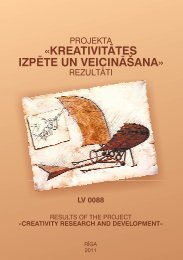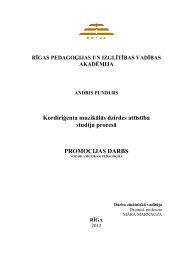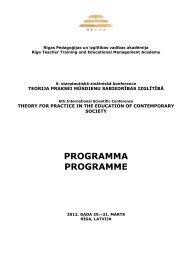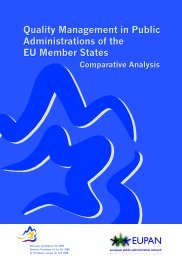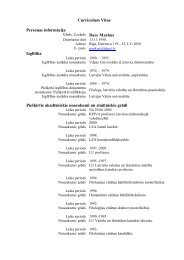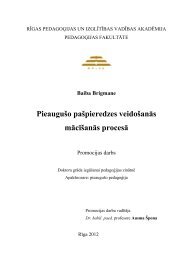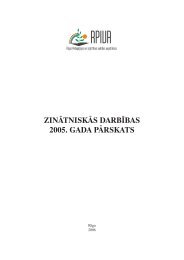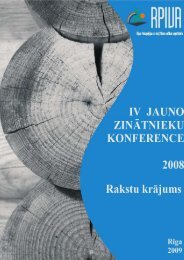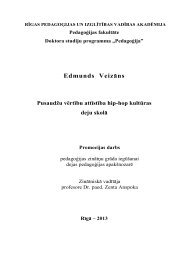saturs - rpiva
saturs - rpiva
saturs - rpiva
- No tags were found...
Create successful ePaper yourself
Turn your PDF publications into a flip-book with our unique Google optimized e-Paper software.
While teacher-fronted presentation of the material is deemed necessary for laying the<br />
groundwork for learning (Fearnside, 2010), student-centered activities such as group discussion,<br />
role play, and peer-assisted learning allow students to become active users of the language and<br />
retain the skills they have learned into their adult lives.<br />
Table 1. Main characteristics of teacher-centered and learner-centered classrooms<br />
Teacher-Centered Classrooms<br />
The teacher is the acknowledged expert on the<br />
material; the teacher lectures, and students<br />
learn.<br />
The teacher dispenses the subject matter;<br />
students passively digest the lesson.<br />
Motivation is external, with students striving<br />
for good grades.<br />
The teacher stands in front of the class;<br />
students are seated in regular rows.<br />
The teacher chooses the material and assigns<br />
projects.<br />
Each student is assessed according to his or her<br />
merits and abilities.<br />
Work is geared toward getting a good grade<br />
and is produced for the teacher.<br />
Work lacks a sense of purpose – students may<br />
perceive it as “busy work.”<br />
Learner-Centered Classrooms<br />
Everyone in the classroom plays an important<br />
role; the teacher is also a learner, and all<br />
students learn from both the teacher and from<br />
each another.<br />
Students are taught to seek understanding<br />
through critical thinking, discussion, and other<br />
methods of active learning.<br />
Motivation is internal, coming from the<br />
students’ interest and desire to learn.<br />
Seating takes on different configurations,<br />
depending on the activity.<br />
The students have a say in the material and<br />
choose the projects they will work on.<br />
Students are encouraged to build on their<br />
strengths, while learning from the contributions<br />
of classmates.<br />
Work is produced for a real-life situation and<br />
feels meaningful to students.<br />
Students feel that their work has meaning in<br />
their lives, with real applications.<br />
Problems with student-centered learning in Turkish schools<br />
Attempting to introduce learner-centered instruction in Turkish classrooms is<br />
problematic for several reasons. First, the educational system itself is traditionally teachercentered,<br />
and the enormous bureaucracy that makes up the Turkish system is highly resistant to<br />
change. Second, teacher education programs do not emphasize unconventional methods of<br />
instruction; prospective teachers are taught the traditional approach of teacher-fronted learning,<br />
with no encouragement to explore alternative teaching styles. Third, the students themselves are<br />
often uncomfortable with critical thinking and independent learning. While forward-thinking<br />
educators may view activities such as dictation, memorization, and recitation as routine and<br />
boring, students who are accustomed to a teacher-centric classroom often find these exercises<br />
reassuring and familiar (Lewis & Reinders, 2008). A brief background of the Turkish school<br />
system will help readers of this article to understand the difficulties of introducing studentfronted<br />
instruction in Turkish EFL classrooms.<br />
RESULTS<br />
Turkish educational standards<br />
Since 1924, Turkish education has been regulated by the Law of Unification of<br />
Instruction, overseen by the Turkish Ministry of Education. Under this system, all schools<br />
32


